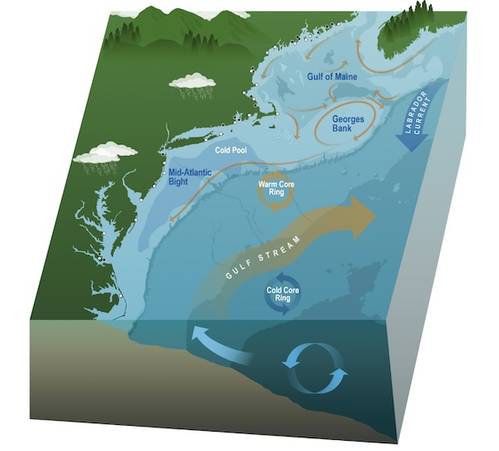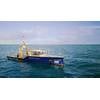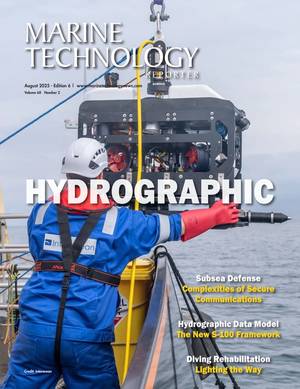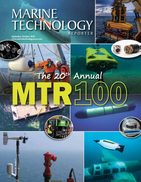NOAA Predicts Cooler Deep Waters for Gulf of Maine

The major currents in the Gulf of Maine and northwest Atlantic are depicted in this illustration. The Gulf of Maine is predicted to experience cooler bottom waters this year, which may improve conditions for important groundfish and lobster populations. Credit: NMFS
The Gulf of Maine, historically one of the fastest-warming ocean regions in the world, is predicted to experience cooler bottom water temperatures this spring and summer, according to a new experimental outlook developed by NOAA scientists.
Initial signs of this shift were reported by NOAA’s Northeast Fisheries Science Center and documented in the NOAA Fisheries 2025 New England State of the Ecosystem Report.
Data shows that since late 2023, the Northwest Atlantic has seen cooler bottom-water temperatures due to the southward movement of the eastern portion of the Gulf Stream and possibly an increased influx of Labrador Slope and Scotian Shelf water into the system. Researchers expect the Gulf of Maine to be 0.9-1.8 degrees Fahrenheit (0.5-1 degree Celsius) cooler this summer compared to the average summer temperature.
Bottom-water temperatures influence the productivity of groundfish, like cod, haddock, pollock and several species of flounder, which prefer cooler water. Lobster, the most valuable fishery in the northeast, are also temperature-sensitive. Warming waters along the New England coast in recent decades have contributed to the collapse of the southern New England lobster population while the Gulf of Maine population has boomed.
Researchers expect that cooler waters will impact this economically and culturally important species.
The commercial fishing industry in New England is a major economic driver, contributing $1.4 billion in revenue to the regional economy in 2022 and supporting over 280,000 jobs. The industry also has a significant socioeconomic impact on coastal communities.
A companion longer-term outlook, also developed by NOAA scientists, suggests that more frequent inflows of cooler deep waters may continue to temper warming in the basin for the next several years. Continued monitoring is needed to confirm this prediction.
“This is the first product to offer high-resolution predictive information on ocean conditions at near-term time scales for the full East Coast of the U.S.,” said Katherine Mills, Senior Scientist at the Gulf of Maine Research Institute. “Species in the groundfish complex—like cod, haddock and winter flounder—are more productive when water temperatures are cooler. This information can be used to anticipate where and when certain marine species might be available and help commercial harvesters and supply chain businesses more effectively plan their operations.”
This seasonal outlook was developed under the Changing Ecosystems and Fisheries Initiative (CEFI) by scientists across NOAA Research and Fisheries, with input from the National Ocean Service, National Environmental Satellite and Data Information Service and the National Weather Service.
The outlook is based on two models developed by NOAA’s Geophysical Fluid Dynamics Laboratory. The first is SPEAR, the “Seamless System for Prediction and Earth System Research”, which provides large-scale predictions for the ocean, atmosphere and land. The SPEAR output is then fed into a higher-resolution regional model, built with the Modular Ocean Model version 6 (MOM6), to simulate ecosystem changes in the coastal regions.
Working in tandem, the two models generate ocean predictions for a wide region along the U.S. East Coast, from the Gulf of Maine through the Southeast U.S. and into the Caribbean Islands. The outlook for the Southeast U.S. and Caribbean regions predicts moderately above-normal surface temperatures through this spring and summer.
Through CEFI, NOAA Research is building out experimental regional ocean prediction systems for all U.S. coastal regions and the Great Lakes that will include information on ocean chemistry (acidity, oxygen) and plankton populations. The regional configurations all rely on NOAA’s global prediction systems for large-scale information while enabling finer resolution of local features critical for fisheries and coastal communities.

This illustration depicts predicted ocean temperature forecasts for 2025 for the northwest Atlantic issued by the Changing Ecosystems and Fishery Initiative. Credit: NOAA GFDL












 August 2025
August 2025



